*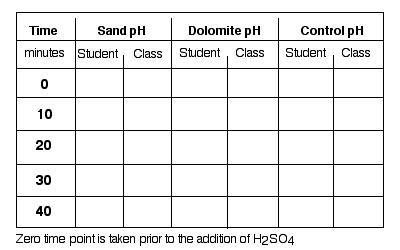
By the end of this lab you will be able to describe
how chemical pollution, thermal pollution and acid rain affect the growth
and reproduction of organisms. You will also determine whether a
water sample is polluted by algae.
INTRODUCTION:
Seldom a day passes in which we do not hear a pollution related story from the media. Oil spills, leaks of toxic chemicals and noise pollution are just a few of the pollution related problems that affect our lives. The effects of pollution can be disastrous, as exemplified by the nuclear explosion at Chernobyl, the Alaskan oil spills, and the dumping of toxic wastes at sites all over the planet. Whether or not it makes headlines, pollution of any kind affects fundamental aspects of life, namely how organisms grow and behave. Because populations of organisms interact among themselves and with the environment, pollution always affects more than one organism. For example, consider the following food chain below:
algae >>> zooplankton >>> small fish >>> large fish >>> mammals
A pollutant that reduces a certain population at any step of this food chain will have a similar effect on all other levels of the food chain, because all steps of the chain are linked. Thus, water polluted with chemicals such as herbicides that kill algae, will ultimately affect populations of zooplankton that eat the algae; this ultimately affects populations of fish and other organisms that are part of the same food chain.
A pollutant is any physical or chemical agent that
decreases the aesthetic value, economic productivity, or health of the
biosphere. There are many kinds of pollutants, such as noise, chemicals,
radiation and heat. In this exercise you will study several of these
types of pollutants. This lab is broken down into 4 sections: Acid
Rain Simulation, Eutrophication Observations, Pesticide Pollution and Thermal
Pollution.
SIMULATING THE EFFECTS OF ACID RAIN
PART 1
Acid rain is a worldwide problem caused by atmospheric
pollution. Compounds such as nitrates and sulfates released into
the atmosphere by automobiles and industries combine with water to form
nitric and sulfuric acids that are deposited across the country in precipitation.
There, the acid decreases the pH of the soil, affecting the availability
of nutrients, and typically diminishes plant growth. The effects
of acid rain are often subtle, but they are significant; for example, the
cumulative pollution of decades of acid rain are now killing forests and
reducing crop yields in many areas. In this exercise, you will study
the influence of acid rain on the enviornment This will be
done by 1) examining how different bedrocks are able to naturally buffer
the effects of acid rain, 2) observing seed germination and 3) the effect
of acid conditions on daphnia Remember to be very careful when handling
the solutions in this lab. Please wear goggles when necessary and
gloves at all times.
A. Observe the natural buffering of lake beds.
Each table will simulate the lake beds.
1) Obtain 3 beakers that will simulate different lake beds and a control.
2) Pour sand to the 100ml mark on the beaker, this will simulate igneous rock.
3) Pour sand to the 100ml mark on the beaker, this will simulate sedimentary rock.
4) The third beaker will be a control for your experiment.
5) To each beaker or “lake” and control add water to the 300ml mark.
6) Take a glass string rod and gently stir
the water in each treatment being careful
not to disturb the
bed rock.
7) Measure the pH of each lake and record it in the chart below.
8) CAREFULLY, take a test tube containing 20ml of sulfuric acid (H2SO4).
9) Pour the 20 ml of sulfuric acid into the
sand lake, stir the water only not the sand
and immediately
measure and record the pH on your chart.
10) Repeat steps 8 and 9 for each lake or treatment.
11) Take pH readings every 10 minutes for 40 minutes and record in your chart.
12) Compare your results with the other groups in the lab.
*
What is the natural buffer in lakes?___________________________________________________________________________________________________________
B Observe seed germination.
1) Examine the three petri dishes labeled
“Acid Rain and Seed Germination”. All of
the dishes were
inoculated several days ago with 25 seeds of corn (zea mays).
Dish 1 contains
seeds soaked in a solution having a pH of 4, and dish 2 contains
seeds soaked in
a solution having a pH of 2.
2) Compare these seeds with those grown in dish 3 at a neutral pH of 7
3) Use the following formula to calculate
the percentage germination for each
treatment.

4) Record your results in the table below.
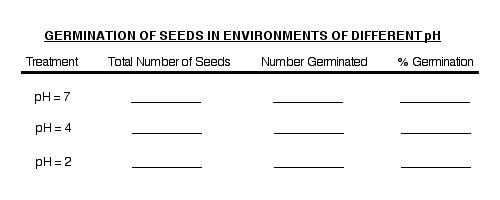
How does a lower pH affect seed germination_________________________________
__________________________________________________________________
C. Observe the effect of acid conditions on Daphnia.
This will be done during the beginning of the lab so observations can be made during class. Your instructor will perform this experiment and you will observe any response the daphnia may have as a result of varying pH during the class period.
1) Your instructor will ask for volunteers to add 20mls of pH 7, pH 4 and pH 2 to the respective beaker.
2) Add 10 daphnia to each of the beakers.
3) Within a few minutes you will begin to see an affect on the daphnia. Record your results of the number of daphnia affected at the end of the lab period.
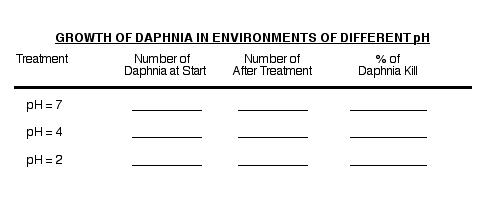
How does acidity affect daphnia?____________________________________________________________________________________________________
_______________________________________________________________
NUTRIENT ENRICHMENT: EUTROPHICATION
PART 2
Bodies of water such as lakes and ponds naturally undergo a nutrient enrichment process called eutrophication. In extreme situations, this enrichment often stimulates growth so much that the lake or pond may eventually fill in and disappear. Human generated pollutants such as raw sewage and fertilizers dramatically speed eutrophication. In this exercise, you’ll study eutrophication by studying the growth of organisms in nutrient enriched media.
Several days ago algal cultures were started with
similar amounts of algae. Culture 1 contains an excess of nitrogen,
a condition similar to that of lakes enriched with raw sewage. Culture
2 contains large amounts of nitrogen and minimal oxygen to simulate anaerobic
conditions. Culture 3 is an aerobically grown control containing
normal amounts of nitrogen.
1) Examine the two algal cultures that represent eutrophication and compare them to the control. Record your observations on the chart which follows.
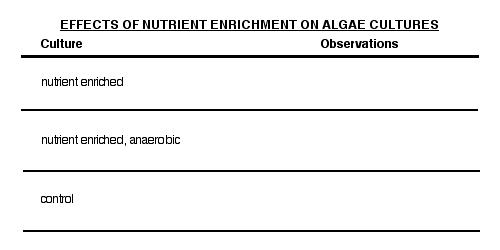
Which culture has the most algal growth.____________________________________
Which culture has the least algal growth.____________________________________
THERMAL POLLUTION
PART 3
Excessive heat is a common pollutant. Many factories use water to cool heat generating equipment. Water used for this cooling is then released into reservoirs or ponds, where it raises the water temperature. Thermal pollution speeds biochemical reactions, thereby altering the growth and composition of populations. Thermal pollution will speed up evaporation of water, thereby concentrating other pollutants in the water. The decrease in the oxygen supply is due to the fact that warmer water holds less oxygen than does cooler water. In the experiment below you will observe the effect of temperature on the survival of Daphnia.
1) Examine the two cultures labeled “Thermal Pollution”.
2) Culture 1 was grown at room temperature,
and culture 2 was grown at 35o C in oxygen depleted water. Record
your observations of each culture in the table
which follows.
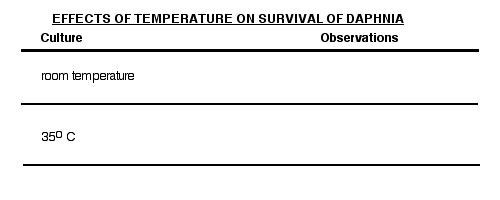
Which culture contains the most living daphnia? ________________________________
Which culture contains the least.____________________________________________